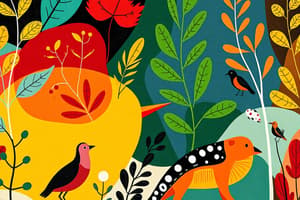Podcast
Questions and Answers
What is the function of chlorophyll in plants?
What is the function of chlorophyll in plants?
- To absorb water and minerals from the soil
- To aid in the digestive process
- To respond to stimuli
- To prepare their own food using sunlight (correct)
What is a common characteristic of animals?
What is a common characteristic of animals?
- Ability to prepare their own food
- Extreme sensitivity to stimuli (correct)
- Ability to derive energy from sunlight
- Need for an adequate supply of nutrients
What is the term for any material necessary for an organism's growth and maintenance?
What is the term for any material necessary for an organism's growth and maintenance?
- Chlorophyll
- Stimulus
- Nutrient (correct)
- Organ system
What do autotrophic species derive energy from?
What do autotrophic species derive energy from?
What is necessary for plants to maintain life?
What is necessary for plants to maintain life?
What are the two routes for water and mineral absorption in plants?
What are the two routes for water and mineral absorption in plants?
What is the primary difference between autotrophic and heterotrophic species?
What is the primary difference between autotrophic and heterotrophic species?
What is the role of chlorophyll in plant nutrition?
What is the role of chlorophyll in plant nutrition?
Why do plants require an adequate supply of water and minerals?
Why do plants require an adequate supply of water and minerals?
What is the primary function of the xylem in plants?
What is the primary function of the xylem in plants?
How do heterotrophic species obtain their nutrition?
How do heterotrophic species obtain their nutrition?
What is the term for the process by which plants create their own food?
What is the term for the process by which plants create their own food?
Why are plants considered self-sufficient?
Why are plants considered self-sufficient?
What is the role of the apoplast route in plant nutrition?
What is the role of the apoplast route in plant nutrition?
What is the primary difference between plants and animals?
What is the primary difference between plants and animals?
What is necessary for autotrophic species to create their own food?
What is necessary for autotrophic species to create their own food?
Flashcards are hidden until you start studying
Study Notes
Nutrition in Living Organisms
- Living organisms require an adequate supply of nutrients for survival, which refers to any material necessary for growth and maintenance.
Autotrophs vs Heterotrophs
- Autotrophs (such as plants) derive energy from sunlight and chemosynthesis bacteria to create their own food through photosynthesis.
- Heterotrophs (such as animals and fungi) do not make their own food and derive their nutrition from other organisms.
Plant Nutrition
- Plants are self-sufficient in terms of nutrition, but also require external resources such as water, carbon dioxide, and minerals for maintenance of life.
- Water and minerals are absorbed by plant roots through two routes: symplast through plasmodesmata and apoplast route along cell walls.
- The conducting tissue of plants, specifically the xylem, must be reached by water and minerals from the soil.
Key Characteristics of Plants and Animals
- Plants have the capacity to prepare their own food with the help of sunlight, water, air, and chlorophyll.
- Animals are characterized by a well-developed body and organ system, and are extremely sensitive to stimuli.
Studying That Suits You
Use AI to generate personalized quizzes and flashcards to suit your learning preferences.




